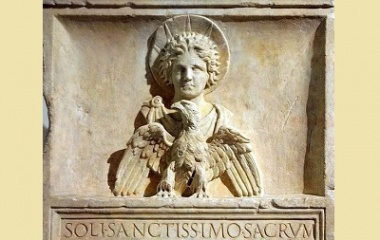- Pronunciation: soul
- Origin: Rome
- Cult Center: Circus Maximus
- Role: Sun god
- Symbols: Sun
Who Is Sol?
Sol Indiges is the one of the most ancient gods of Roman mythology. Early history has him recorded as one of the many deities introduced by Emperor Titus of the Flavian Dynasty. The sun god disappeared from the literature for some time and was later reintroduced by Emperor Aurelian as Sol Invictus, which means “unconquered sun”. The name differentiation may have come later to help people discern between the myths of the two.
Origin
Sol Indiges
Sol Indiges was one of the earliest gods introduced by Titus in approximately 79AD, during a time when the Romans and Sabines were allies. In the Aeneid, Virgil’s epic Latin poem, the Trojan hero Aeneas, was a Roman who fled to Italy following the defeat of Troy. Once there, he married the daughter of Latinus, a Latin king. The mother of Latinus was Circe, the daughter of the sun. This marriage into the family of the sun shows the importance of the deity for the Roman state, and is also a sign of the unity of the Latins and Romans.
Several festivals were held and dedicated to the sun god. On the August 9 at the cult center temple on Quirinal was the feria (festival) in honor of the sun, which is needed for the nurture of a good harvest.
On August 28 the dedication of Templum Sol et Luna (Sun and Moon) was held at the Circus Maximus, which was the main temple the sun god shared with the moon goddess. Circus is derived from the name Circe, daughter of the sun.
Sol Invictus
The Emperor Aurelian reintroduced the sun god and cult in 274 AD. The birthday of the unconquered sun was celebrated at the Roman festival Dies Natalis Solis Invicti on December 25. There is an ongoing debate regarding this date. Did it predate Christmas, or was it was later chosen to be the same day? We do know that Sol Invictus was worshipped in Rome until Christianity took hold as the dominant religion during the reign of Constantine in the 300s A.D.
Historical Influence
Some believe December 25 was chosen as the date of Christmas Day after the pagan holiday celebration of Sol Invictus, while other theories say the date for Christmas was chosen first. Romans believed that Sol had died for three days and was reborn on December 25. The three days following December 21 are the darkest of the year: the three days when neither the sun nor Jesus are seen.
There are theories that connect Christianity to astrology and the sun. Jesus had 12 disciples, and this corresponds to the 12 constellations of the zodiac. The halo in many paintings of Christ bears a resemblance to the cross of the zodiac.
The sun god also had a role in the secret religion of Mithraism, which was practiced during the 1st to 4th centuries of the Roman Empire. It is not clear whether Sol can definitively be identified as Mithra – who was originally a Persian god – but it is known that the cult center for Mithraism was in Rome.
Sol Invictus is found on many ancient Roman coins, as several of the Emperors of Rome during the later era were preferential to Sol, including Constantine the Great, who was committed to the sun god in addition to Christianity.











what is the animal of sol
what is the symbol
Sun